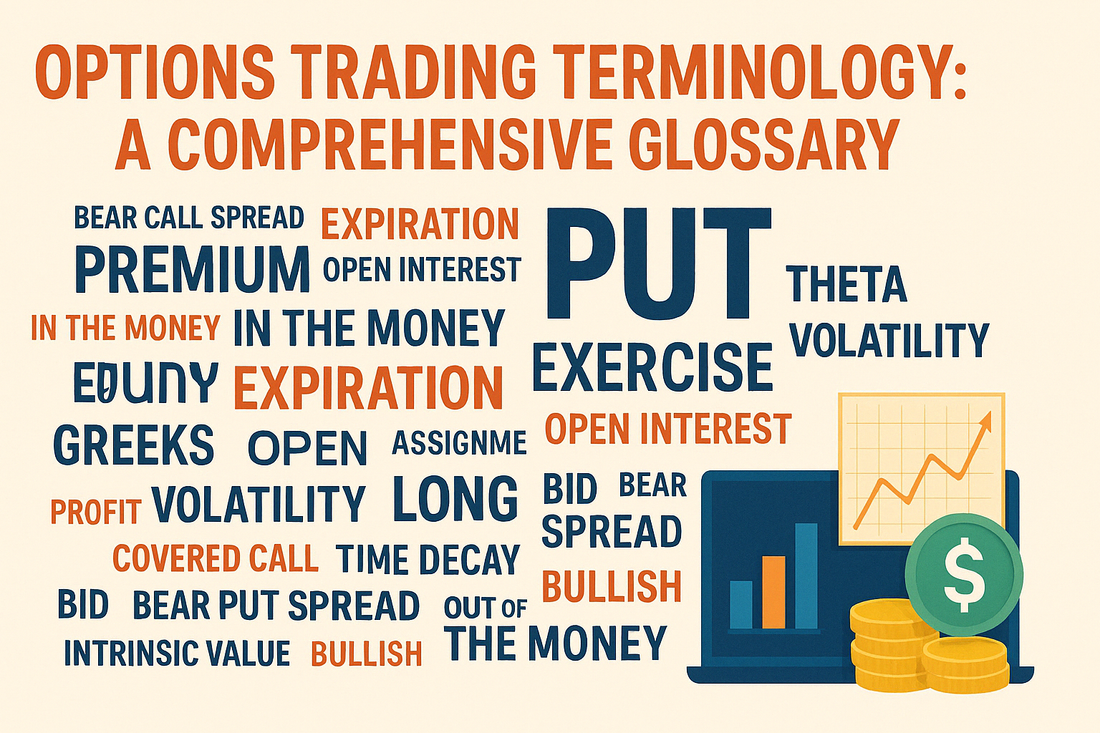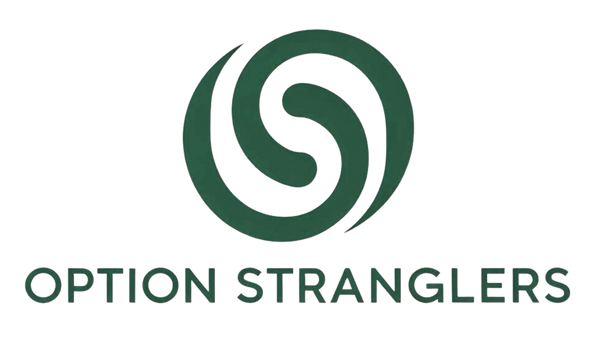
Options Trading Terminology: A Comprehensive Glossary
Introduction: Why Knowing the Lingo Matters
In the world of options trading, understanding the language is as crucial as mastering the strategies themselves. The options market is filled with abbreviations, complex terms, and nuanced jargon that can seem overwhelming to beginners. Yet, fluency in this terminology is the foundation for confident, self-sufficient trading.
Whether you're analyzing an iron condor, considering time decay, or managing implied volatility, every decision begins with a solid grasp of key terms. This glossary offers a detailed, alphabetically organized list of essential options trading terms, complete with definitions and examples, so you can quickly gain the fluency needed to take control of your financial future.
Ready to escape the rat race? Let’s build your options vocabulary.
A to Z: Options Trading Terms, Definitions & Examples
A
American-Style Option
Definition: An option that can be exercised at any time before or at expiration.
Example: Most equity options traded in the U.S. are American-style.
Assignment
Definition: The process by which the seller of an option is notified that the buyer has exercised the option.
Example: If you sold a put and the stock drops below the strike, you may be assigned and forced to buy the stock.
At-the-Money (ATM)
Definition: When the option's strike price is equal to the price of the underlying asset.
Example: A call option on AAPL with a strike price of $150 when AAPL is trading at $150 is ATM.
B
Backtesting
Definition: Evaluating a strategy using historical data to assess performance.
Example: Before live trading, backtest an iron condor strategy using 5 years of SPY data.
🔗 Read: How to Use Backtesting Software for Options Strategies
Bear Spread
Definition: An options strategy designed to profit from a decline in the price of the underlying.
Example: Buying a put at $100 and selling a put at $95 is a bear put spread.
Bid-Ask Spread
Definition: The difference between the highest price a buyer is willing to pay (bid) and the lowest price a seller will accept (ask).
Example: A wide bid-ask spread indicates low liquidity.
C
Call Option
Definition: A contract that gives the holder the right to buy an asset at a specified price before expiration.
Example: Buying a call on TSLA means you're bullish and expect the price to rise.
Covered Call
Definition: A strategy where a trader owns the underlying asset and sells a call option against it.
Example: Selling a $50 call on a stock you own that’s trading at $48.
Credit Spread
Definition: A strategy where the premium received from the sold option exceeds that of the bought option.
Example: A bull put spread creates a net credit.
D
Delta
Definition: A Greek that measures how much an option's price is expected to move per $1 change in the underlying asset.
Example: A delta of 0.6 means the option will increase by $0.60 if the underlying goes up by $1.
Debit Spread
Definition: A strategy where the premium paid for the long option is higher than the premium received for the short option.
Example: Bull call spreads are debit spreads.
Derivatives
Definition: Financial instruments whose value is derived from an underlying asset.
Example: Options are derivatives of stocks or ETFs.
E
European-Style Option
Definition: Can only be exercised at expiration.
Example: Many index options, like SPX, are European-style.
Ex-Dividend Date
Definition: The date on which a stock starts trading without the value of its next dividend payment.
Example: Option pricing may adjust near this date.
Expiration Date
Definition: The last date on which an option can be exercised.
Example: Weekly options expire each Friday.
F
Front Month
Definition: The nearest expiration month for a listed options contract.
Example: If it’s March 10, a March 15 expiration is the front month.
Fundamentals
Definition: Company data like earnings, revenue, and financials used in analysis.
Example: Traders often mix options strategies with strong fundamentals.
🔗 Read: Fundamental Analysis for Options Traders
G
Gamma
Definition: The rate of change of delta. Indicates how delta changes when the stock price changes.
Example: High gamma means your delta can shift rapidly—common near expiration.
Greeks
Definition: Statistical values that measure risk and sensitivity of options (Delta, Gamma, Theta, Vega, Rho).
Example: Understanding Greeks is crucial to risk management.
H
Hedging
Definition: Reducing risk by taking an offsetting position.
Example: Buying puts to hedge a long equity position.
🔗 Read: Leveraging Options for Portfolio Hedging
I
Implied Volatility (IV)
Definition: The market’s forecast of a likely movement in a security’s price.
Example: Higher IV increases option premiums.
In-the-Money (ITM)
Definition: A call is ITM when the underlying is above the strike; a put is ITM when it is below.
Example: A $90 call on a $100 stock is ITM.
Iron Condor
Definition: A neutral strategy combining a bull put spread and a bear call spread.
Example: Profit is maximized if the stock stays between the inner strikes.
J
Junk Option
Definition: A very cheap, often far OTM option with low probability of success.
Example: Buying a $200 call on a $100 stock expiring tomorrow.
K
Kurtosis
Definition: A statistical measure describing the tails and peaks of a distribution.
Example: High kurtosis = more “black swan” events.
L
Liquidity
Definition: The ease with which you can enter or exit positions.
Example: Trade high-volume options for better fills.
LEAPS (Long-Term Equity Anticipation Securities)
Definition: Options with expiration dates greater than one year.
Example: Useful for long-term directional plays.
M
Margin
Definition: Collateral required to open or maintain certain trades.
Example: Selling naked options typically requires margin.
Market Order
Definition: An order to buy or sell immediately at the best available price.
Example: May lead to slippage in illiquid markets.
Moneyness
Definition: Describes if an option is ITM, ATM, or OTM.
Example: Determines intrinsic vs. extrinsic value.
N
Naked Option
Definition: An option sold without a corresponding position in the underlying.
Example: Selling a call without owning the stock.
O
Open Interest
Definition: The number of active contracts not yet closed or delivered.
Example: Higher OI = more liquidity.
Out-of-the-Money (OTM)
Definition: A call is OTM when the underlying is below strike; a put is OTM when it’s above.
Example: $120 call on $100 stock is OTM.
P
Put Option
Definition: A contract giving the holder the right to sell the underlying at a specified price.
Example: Use puts to profit from downward moves.
Protective Put
Definition: Buying a put to protect a long stock position.
Example: Acts like insurance against a decline.
Q
Quote
Definition: Current bid and ask prices.
Example: Option quote may show $2.00/$2.10.
R
Resistance
Definition: A price level where a stock struggles to move above.
Example: Useful in identifying call spread opportunities.
Rho
Definition: Measures sensitivity to interest rate changes.
Example: Least impactful Greek for most traders.
S
Strike Price
Definition: The price at which the option can be exercised.
Example: A $100 strike means buying/selling at $100.
Spread
Definition: A strategy involving two or more options.
Example: Vertical spreads, calendar spreads, diagonal spreads.
Synthetic Position
Definition: An options combination that mimics the payoff of another position.
Example: Long call + short put = synthetic long stock.
T
Theta
Definition: Measures time decay of an option.
Example: Theta = -0.05 means the option loses $0.05/day.
Trailing Stop
Definition: A stop order that adjusts as the trade becomes profitable.
Example: Useful in managing swing trades.
U
Underlying Asset
Definition: The financial instrument on which the option is based.
Example: AAPL options are based on AAPL stock.
Unwinding
Definition: Closing out an options position.
Example: Taking profit or loss before expiration.
V
Vega
Definition: Measures sensitivity to changes in implied volatility.
Example: Long Vega benefits from rising IV.
Volatility Skew
Definition: Uneven IV across strikes.
Example: Useful in identifying cheap or expensive options.
🔗 Read: Creating and Interpreting Options Volatility Skews
W
Weekly Options
Definition: Options that expire every week.
Example: Ideal for earnings plays or quick trades.
Wide Spread
Definition: A large bid-ask difference.
Example: Often found in illiquid or far-dated options.
X
Exercise Price
Definition: Synonymous with strike price.
Example: Used when exercising the right to buy/sell.
Y
Yield Curve
Definition: Graph showing interest rates over various time horizons.
Example: Affects long-term option pricing.
Z
Zero-Cost Collar
Definition: Protective strategy using a long put and a short call.
Example: Limits both upside and downside.
📘 Illustration: Word Cloud Cheat Sheet

🎯 Be A Proficient Options Trader
At www.optionstranglers.com.sg we offer:
- ✅ In-depth live 1-1 sessions / group classes
- 📈 Real trade examples and breakdowns
- 🧠 Community mentorship and support
👉 Ready to upgrade your strategy and trade like a pro? Visit www.optionstranglers.com.sg and start your journey to financial freedom today.
Your future is an option. Choose wisely.
⚠️ Disclaimer:
Options involve risk and are not suitable for all investors. Always consult with a financial advisor before investing.
